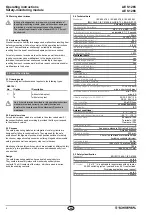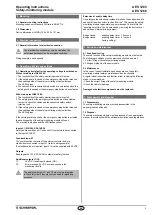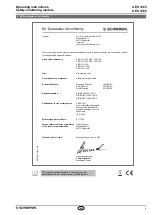
3
AES 1265
AES 1266
Operating instructions
Safety-monitoring module
EN
3. Mounting
3.1 General mounting instructions
Mounting: snaps onto standard DIN rails to EN 60715.
3.2 Dimensions
Device dimensions (H/W/D): 100 x 22.5 x 121 mm
4. Electrical connection
4.1 General information for electrical connection
The electrical connection may only be carried out by
authorised personnel in a de-energised condition.
Wiring examples: see appendix
5. Operating principle and settings
5.1 Operating principle after the operating voltage is switched on
Without start-up test AES 1265:
1. The functionality of the safety-monitoring module is tested.
2. If the safety guard is closed or the emergency stop button released,
the enabling paths of the safety-monitoring module will close.
The LED is green.
3. The cable and the connected safety switch are only tested when the
safety guard is opened or the emergency stop button when actuated
With start-up test AES 1266:
1. The functionality of the safety-monitoring module is tested.
2. The safety guard or the emergency stop button must be actuated,
in order to check the cables and the connected safety switch
(start-up test).
3. If the safety guard is closed or the emergency stop button released,
the enabling paths of the safety-monitoring module will close.
The LED is green.
If the safety guard is opened or the emergency-stop button is actuated,
the enabling paths of the safety-monitoring module will open.
The machine is stopped and the LED flashes yellow.
Inputs S1-S14/S22; S2-S14/S22
Safety switches with one NC and one NO contact must be connected
to the inputs S14/S22.
Feedback loop: X1
The positive action contacts of the external contactor and/or a
start button is connected to input X1 (refer to wiring example).
If no feedback loop is required, input X1 must be supplied with 24 VDC.
Outputs
Enabling paths 13-14, 23-24: NO contacts for safety function
Additional outputs Y1/Y2:
Y1:
24 VDC, if enable path closed (NO)
Y2:
Error message, 24 VDC on cross-circuits in the
monitoring circuits
The additional outputs Y1 and Y2 must not be integrated
in the safety circuit; they may only be used for signalling
purposes.
Extension of enable delay time
On safety guards with strong residual vibrations, the end position of a
non-contact position switch is often "overrun". This causes the safety-
monitoring module to generate an error message. To avoid this, the
"enabling delay time" can be extended by removing the device cover
and setting an internal bridge (jumper).
Bridge closed:
enabling delay time = 1.0 second
Bridge closed:
enabling delay time = 0.1 second
(factory setting)
6. Set-up and maintenance
6.1 Functional testing
The safety function of the safety-monitoring module must be tested.
The following conditions must be previously checked and met:
1. Correct fitting of the safety-monitoring module
2. Fitting and integrity of the power cable
6.2 Maintenance
In the case of correct installation and adequate use, the safety-
monitoring module features maintenance-free functionality.
A regular visual inspection and functional test, including the following
steps, is recommended:
• Check the correct fixing of the safety monitoring module
• Check the cable for damage.
Damaged or defective components must be replaced.
7. Disassembly and disposal
7.1 Disassembly
The safety monitoring module must be disassembled in the
de-energised condition only.
7.2 Disposal
The safety monitoring module must be disposed of in an appropriate
manner in accordance with the national prescriptions and legislations.
























